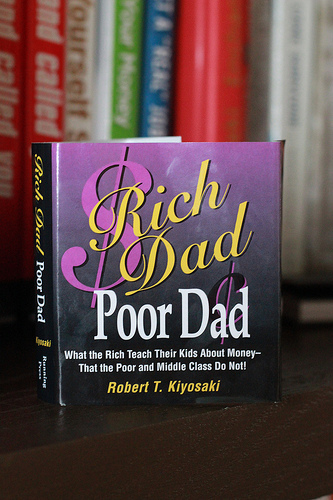Since its debut in 1997, Robert T. Kiyosaki’s Robert Kiyosaki’s Rich Dad, Poor Dad has been a landmark among personal finance books, a best-seller that has sold nearly 40 million copies worldwide.
Introduction
Rich Dad Poor Dad by Robert Kiyosaki is one of the most influential personal finance books of all time. It challenges traditional beliefs about money and teaches readers how to think like the wealthy.
The book contrasts two father figures—Kiyosaki’s biological father (the “Poor Dad”) and his best friend’s father (the “Rich Dad”)—who have drastically different attitudes toward wealth.
This summary highlights the book’s five key lessons to help you build financial freedom
1. The Rich Don’t Work for Money—They Make Money Work for Them
Most people work for a paycheck, but the wealthy focus on building assets that generate income. Instead of trading time for money, rich individuals invest in businesses, real estate, and stocks that work for them.
The key takeaway? Don’t rely solely on a job—create multiple income streams that allow you to achieve financial independence.
2. Financial Education Matters More Than a High Salary
Kiyosaki emphasizes that schools teach academic subjects but rarely cover financial literacy. Without understanding money, investing, and wealth-building strategies, even high earners can struggle financially.
To gain financial freedom, you must continuously educate yourself about money management, investments, and financial planning.
3. Buy Assets, Not Liabilities
One of the book’s most powerful lessons is understanding the difference between assets and liabilities:
- Assets generate income (e.g., rental properties, stocks, businesses).
- Liabilities drain your income (e.g., luxury cars, high-interest loans, expensive mortgages). Wealthy people prioritize acquiring income-generating assets instead of accumulating liabilities that decrease their financial stability.
4. Work to Learn, Not Just to Earn
Many people chase high-paying jobs, but Kiyosaki advises focusing on skill development instead. Learning about sales, investing, marketing, and leadership will provide long-term financial benefits.
He encourages working in roles that build valuable knowledge and experience, rather than just offering a paycheck.
5. The Power of Entrepreneurship & Passive Income
Kiyosaki advocates for entrepreneurship and passive income streams. Starting a business, investing in real estate, or creating royalty-based income can help achieve financial independence.
The ultimate goal is to move away from being solely an employee and towards becoming an investor or business owner who generates wealth over time.
Final Thoughts
Rich Dad Poor Dad isn’t just a book about money—it’s a mindset shift. By focusing on financial education, acquiring assets, and developing multiple income streams, anyone can break free from the paycheck-to-paycheck cycle. The journey to financial freedom starts with learning, investing, and thinking like the wealthy.
Which lesson resonated with you the most? Share your thoughts in the comments below!
2 paths diverged in a wood, and I –
I took the one less traveled by,
And that has made all the difference.
Robert Frost, The Road Not Taken
Weak Points:
- A certain lack of detail in some areas mentioned by the author is regrettable.
- As he says himself, his books are motivational tools, not books by a financial expert.


One thought on “Rich Dad Poor Dad Review: 5 Key Lessons to Build Wealth”